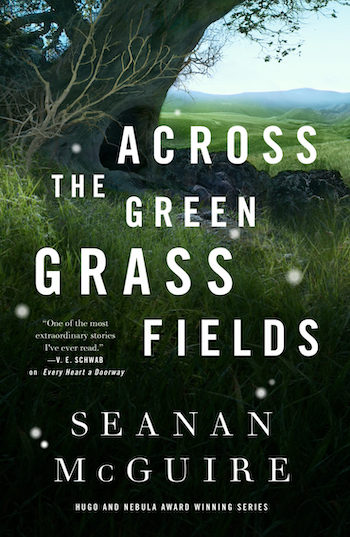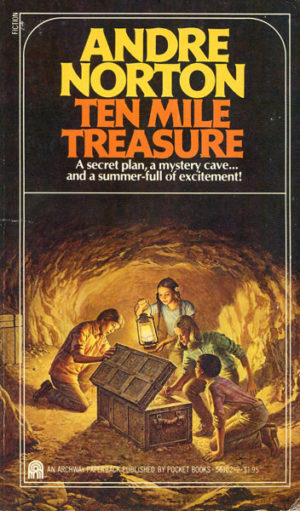First of all, apologies for not giving my usual heads-up at the end of the last Norton Reread post. It’s been a uniquely distracted few weeks on all levels, from the personal on up.
In any case, I felt I needed something light, something bright and simple and escapist, and Ten Mile Treasure seemed like just the thing. It’s a middle-grade book as we call such books now, published in 1981, and it’s set more or less in my backyard. The setup is classic: Four kids move with their parents to an old ranch. They deal with a family crisis. They find hidden treasure. They face off against a bad man and his nasty daughter. They solve a century-old mystery, and save the day.
The ranch is set in Arizona, and it and the landscape it sits in are lovingly detailed. I knew in which month the action happens because of what was blooming in the various scenes, and the old mine and the ghost town and the hidden canyon are all very typical. There’s a classic Crusty Old Cowboy with a classic howdy-pardner accent, complete with luxuriant moustache and leather farrier’s apron standing for chaps.
The protagonist, Christie, had echoes for me of Meg Murry: She’s bookish, intense, and her glasses often slip down her nose. She shares adventures with her older brother Neal; her much younger twin siblings tag along, require much babysitting, and get into frequent trouble. The family dog is a regular participant in the action; the family cat, a strikingly beautiful Siamese-Burmese cross who is dragged hither and yon on a leash, even more so. It’s the cat who finds the treasure, because of course he does.
Buy the Book


Across the Green Grass Fields
The animals are as much a part of the story as the humans, and they’re delightful. Besides the family pets, there’s a pair of elderly horses and a pair of donkeys, one of whom has a baby of small size but enormous vocal volume, named Jericho. Wild animals and birds are less individual but omnipresent, from a chuckwalla in a rock wall to a pack of coyotes singing outside the ranch at night to a roadrunner crossing the road.
There’s a strong sense of place, and a strong sense of history, too. The ranch was an old stagecoach depot, which the children’s father plans to turn into a roadside attraction as a new highway goes in just a couple of miles away. The ghost town nearby thrived and died along with its mine; its buildings still stand, if precariously, and most have been left as they were, right down to furniture and tools and even hotel registers. The treasure is a trove of knowledge and artifacts from 1875, in the heyday of the stage line. And the resolution of the conflict over the ranch goes back to century-old treaties and grants of rights not only with the U.S. Government but with the neighboring Navajo Nation.
The Navajo are very much a part of the story. A young family, the Wildhorses, park their camper-caravan at the ranch every summer, and their son and daughter become close friends with Neal and Christie. Norton does what she does every time she writes about Native Americans: She goes on about how they’re “not what people usually expect,” and explains that the father is a geologist and the mother is a famous painter. But they’re also kind of nomadic, and aren’t connected to any particular place or institution, though they have plenty of connections with the reservation.
This is the kind of book that aims to teach while it tells an interesting and engaging story. I think it works. It teaches without preaching too much, and the history ties in closely with the main plot conflict and the family’s need for a safe and secure place to live. The resolution is satisfying; the plot threads tie together nicely.
But—there’s usually a but. It’s not a bad one or a dealbreaker, but.
There’s a fair bit made out of the saguaros growing on the ranch, which are in bloom. That’s generally accurate for April—at a particular altitude.
That altitude does not exist in the Navajo Nation. Nor do saguaro grow there. That land is too high and too far north.
The land Norton describes is a lot farther south, much closer to the Mexican border. Saguaro bloom in April around Phoenix and into southwest Arizona, in the opposite corner of the state from the Navajo Nation, which is huge, spreading from northeastern Arizona through New Mexico and Utah. The land she’s describing is actually pretty accurate for southern Arizona, and there is a Tenmile Wash down that way, parts of which run just a couple of miles from a highway that would have been fairly new in 1980.
That’s Tohono O’odham country, though she might have known them as the Papago. It’s a pejorative term, as so many settler names for tribes tend to be. A Navajo family might spend summers at a ranch in that area, but they’d be a fair few hundred miles from the Nation.
I have therefore established a headcanon for this book. The workers who come to the ranch are actually O’odham, though they’re good friends with the Whitehorses. The ranch was a station on one of the stage lines that ran from southern California through Tucson. Might even have been the one up the road from me, La Posta Quemada, which means “the stagecoach depot that was burned by Apaches.”
Posta Quemada is now regional park land, the centerpiece of which is a large dry cave known as a hideout for robbers and raiders. It has ghosts and may have treasure hidden deep inside. And under it, hundreds of feet deep and running underground through the entire region, are incredible limestone caverns that rival the Glittering Caves of Aglarond. A branch of them opened to the public a couple of decades ago, at Kartchner Caverns.
Even the spring at Ten Mile Ranch has analogues in the region. The water I drink comes from a well sunk into the caverns, and it’s cold and pure, the best water in the valley. Springs crop out here and there, and were literal lifesavers for people living and traveling in the desert before cars and highways and regional water authorities.
Normally I read with a more objective frame of mind, tending toward the academic, but this book put me in kid mode. I read it not only as the work of a favorite author, but as a world I could see myself living in. My herd of elderly horses, the burros down the hill, send off echoes of Ten Mile Ranch, and there are plenty of Crusty Cowboys and adventurous kids all around us.
I’m heading back out to sea next time in one of Norton’s early works, the pirate adventure Scarface.
Judith Tarr’s first novel, The Isle of Glass, appeared in 1985. Since then she’s written novels and shorter works of historical fiction and historical fantasy and epic fantasy and space opera and contemporary fantasy, many of which have been reborn as ebooks. She has even written a primer for writers: Writing Horses: The Fine Art of Getting It Right. She has won the Crawford Award, and been a finalist for the World Fantasy Award and the Locus Award. She lives in Arizona with an assortment of cats, a blue-eyed dog, and a herd of Lipizzan horses.










